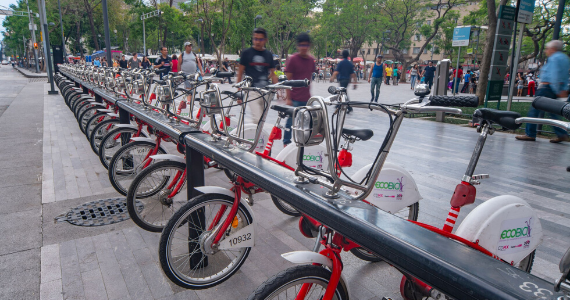Promoting Bicycle Use During COVID-19-CDMX, Mexico
Effects of Improved Bicycling Infrastructure Developed in Response To Covid-19: A Natural Experiment in Mexico City
Active transportation in Mexico City
Mexico City residents are becoming more sedentary, and Mexico City experiences consistently high levels of air pollution. Increased use of bicycles for commuting can promote physical activity among a population experiencing high rates of obesity and diabetes, as well as reductions in transportation-related emissions that contribute to air pollution and climate change. Bicycle sharing programs and improved cycling infrastructure such as separated bike lanes have the potential to improve safety and increase the number of people in cities that use bicycles to commute or exercise.
Mexico City has been investing in improving its cycling infrastructure, particularly for active travel purposes over the past 10 years. Ecobici, a publicly operated bicycle-sharing program, opened in 2010, funded by the Mexico City government and implemented by the Secretariat of Environment. To-date, a total of 480 Ecobici stations and more than 6,800 bicycles are operating in eight neighborhoods. More than 276,000 people have become members of the program since it launched in 2010, making Ecobici one of the largest bicycle-sharing programs in Latin America. The city also has more than 250 km of cycleways, around half of which are protected bicycle lanes.
In the face of the COVID-19 pandemic, many cities around the world established emergency bicycle lanes and other infrastructure to promote active transit, reduce crowding and viral transmission on public transportation, and provide opportunities for physical activity. In Mexico City, scheduled expansions to the Ecobici program were delayed as a result of COVID-19, but the local government implemented alternative interventions to promote cycling and increase traffic safety across the city. Over 50km of temporary bicycle lanes were created on strategically located, high-occupancy roads and highways. Other measures were developed to improve safety, including barriers between cyclists and motor vehicles, improved on-street markings, and enhanced traffic signals. The city government has since decided to make many of these changes permanent.

The SALURBAL Study
SALURBAL researchers from the National Institute of Public Health in Mexico (INSP) and Washington University in St. Louis, in collaboration with the local Secretariat of Mobility in Mexico City, originally planned to measure the effects of expansions to the Ecobici system on ridership. In the face of COVID-19 related delays to these changes, the team has adapted their research questions and study design.
The ongoing SALURBAL study seeks to understand changes in travel behavior and physical activity driven by the new bicycling infrastructure developed by Mexico City in response to COVID-19. While initially temporary, the decision to make these changes permanent and continue infrastructure improvements means that the research team can assess both short-term and longer-term changes in commuter behavior and physical activity.
Specifically, the study aims to:
- Capture short- and long-term changes in bicycle ridership after the implementation of cycling infrastructure expansions.
- Determine which types of transportation people stop using when they start bicycling.
- Observe differences in overall and transport-related physical activity between Ecobici users, other bicycle users, and non-bicycle users.
- Explore specific questions about Ecobici, its users and behavior, including:
- variations in Ecobici users’ demographics (such as age groups and gender participation) over time
- the contribution of Ecobici to meeting physical activity recommendations among users
- neighborhood-level social and built environment characteristics associated with utilization of Ecobici stations.
Researchers are collecting data using questionnaires, street audits, GIS data, GPS data, accelerometry, and direct observation. They have worked directly with the Secretariat of Mobility to gain access to Ecobici’s historical database to analyze ridership and usage patterns over time.
Study Timeline

Partnerships and Collaborators
The Mexico City Secretariat of Mobility has made this policy evaluation possible through their active participation and willingness to share data. The participation of Mexico City residents who have generously given their time and input to support the data collection process has been key to this study’s success.